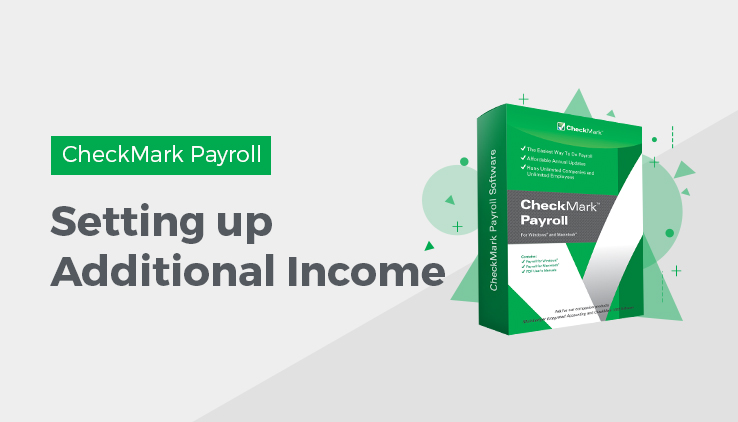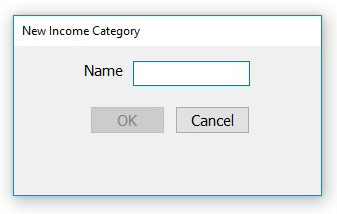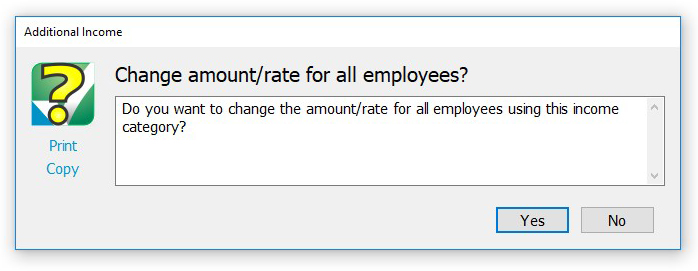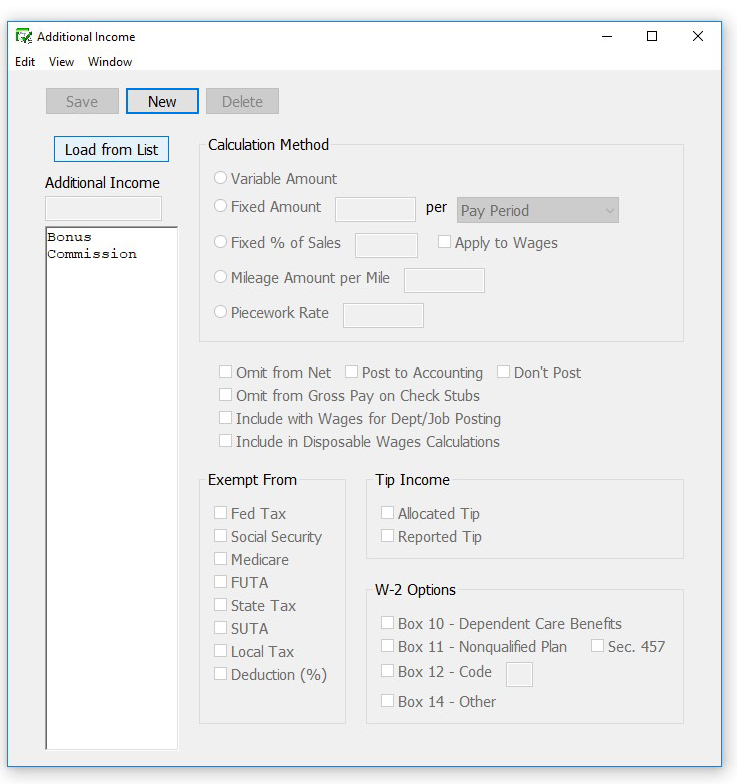
Setting Up Additional Income
The Additional Income window allows you to set up the types of income, such as mileage or tips, that your company uses in addition to a salary or hourly wages to calculate an employee’s pay. You can set up additional income in CheckMark Payroll of your own or add pre-defined categories which can be modified if need be.
Note: You can assign ledger accounts to each Additional Income category for transferring or posting Additional Income amounts to an accounting system. See Setting Up Ledger Accounts.
You can add up to 40 Additional Income categories for your company and assign up to eight per employee.
Once set up on the Additional Income window, a category can be assigned to an employee on the Employees window. See “Setting Up Employee Additional Income.”
Important: Do not delete any Additional Income categories once the first check for the year has been created. The only time a category should be deleted is after the New Year file has been created, but before any checks have been created.
Important: Do not change the tax status on any Additional Income category once the first check of the year has been created. To make a change to the tax set up mid year, stop the category from being applied by simply modifying the amount/rate to zero. Then create a new category with the correct tax set up to be applied.
Adding Pre-Defined Additional Income Categories to Your Company
Important: Pre-defined incomes are setup using general tax guidelines. Verify the tax setup with current tax laws including your state and/or locality. You can modify any pre-defined income.
- Click Setup in the Command Center, then select Additional Income.
- Click Load from List…
- Select one or more categories from the list.

- Click OK.
Creating a New Additional Income Category
If you need an Additional Income category that’s not pre-defined, use the New button to create a new one.
Note: When adding a new income (not applicable for Variable calculation) or modifying a rate or amount, you will be prompted to “Change Amount/Rate for all employees assigned this income category?” when you click Save. If this is a new income category setup, selecting either Yes or No will have no effect. If you modify an existing income category:
– Clicking Yes overrides any specific amount entered on the Employees window to the amount/rate entered and saved on the additional Income window.
– Clicking No leaves the specific amount entered on the Employees window.
- Click Setup in the Command Center, then select Additional Income.
- Click New.

- Enter a name, up to 12 characters long, for the category and click OK.
- Select the calculation method for the Additional Income category. See “Calculation Methods.”
- Define the Additional Income parameters. For more information on what each parameter means, See “Items in the Additional Income Window.”
Tip: If the rate/amount of the Additional Income is the same for ALL employees – enter the rate/amount in the edit box on this window. Then, that amount will be entered on the Calculate Pay window for all employees you assign the Additional Income to on the Employees window.
If the rate/amount of the Additional Income is different for each employee – enter zeroes on this window. Then, modify the rate/amount on the Employee window when you assign the income to the employee.
- Click Save when you have finished defining the category.
Modifying an Additional Income Category
Important: Do not change the tax status on any Additional Income category once the first check of the year has been created. To make a change to the tax set up mid year, stop the category from being applied by simply modifying the amount/rate to zero. Then create a new category with the correct tax set up to be applied.
- Click Setup in the Command Center, then select Additional Income.
- Select the category from the Additional Income list.
- Make the necessary changes to the category’s definition.
- Click Save.
- When modifying a rate or amount, you will be prompted to change for all employees. Select yes or no.

Yes Clicking Yes overrides any specific amount entered in the EmployeeSet Up window under the employees Income Tab screen
No Clicking No leaves the specific amount in the Employee Set Up window under the employees Income Tab screen as previously entered
- Example 1: You update the amount of mileage reimbursement from .445 cents/mile to .565 cents/mile in the Additional Income window and click Save. When prompted to Change Amount/Rate, clicking Yes will update all employees that have the mileage category assigned and update those values regardless of what value was entered previously.
- Example 2: You set up a category for commissions based on percent of sales. Each employee this applies to might have their own specific amount. When saving this category, selecting No upon this Change Amount/Rate screen, all values entered in the Employee Set Up screen under the Income tab will remain and each person will continue to have specific amounts.
Note: If no employees have this category assigned to them in the Employee Set Up window, selecting Yes or No will have no effect
Deleting an Additional Income Category
You can delete an Additional Income category as long as there aren’t any employee checks or year-to-date balances associated with it and it is not assigned to any employees.
Important: Do not delete any Additional Income categories once the first check for the year has been created. The only time a category should be deleted is after the New Year file has been created, but before any checks have been created.
- Click Setup in the Command Center, then select Additional Income.
- Select the category from the Additional Income list.
- Click Delete.
CheckMark Payroll asks you to verify that you want to delete the Additional Income category.
- Click Yes to delete the category.
Items in the Additional Income Window
Calculation Methods
| Variable Amount |
Amount paid to an employee varies with each pay period. If this option is selected, the amount that appears on the Calculate Pay window will always be 0.00 until you override and enter the amount of the additional income. |
| Fixed Amount per Pay
Period, Hour Worked, 1st Chk of Month, or 1st Chk of the Quarter |
Select Fixed Amount per Pay Period if the amount paid to an employee is the same each pay period. Select Fixed Amount per Hour Worked, if the amount paid to an employee is multiplied by the number of hours worked that pay period. Hour Categories defined with Use in Calculations Based on Hours Worked are used in this calculation. Select Fixed Amount per 1st Check of Month if the amount paid to an employee is the same each month. The amount will be added to the first paycheck created for the month. Select Fixed Amount per 1st Check of the Quarter if the amount paid to an employee is the same each quarter. The amount will be added to the first paycheck created for the quarter. There are two ways to handle a Fixed Amount income category: |
| Fixed % of Sales |
Select Fixed % of Sales if the Additional Income should be calculated as a fixed percentage of an employee’s total sales, such as a commission. The value entered here should be a percent, not a decimal value. For example, a decimal value of .015 should be entered as 1.5. |
| Apply to Wages |
With option Fixed % of Sales selected, select Apply to Wage check box if the Additional Income should be calculated as a fixed percentage of an employee’s total wages. The value entered should be a percent, not a decimal value. For example a decimal rate of .015 should be entered as 1.5. |
There are two ways to handle a Fixed % of Sales or Fixed % of Wages income category:
- If the Fixed % is the same for all employees:
You can enter the rate/amount in the edit box on this window. This for all employees who are set up to receive this Additional Income.
Mileage Amount per Mile
- If the Fixed % is the different for each employee:
You can modify the amount for each employee on the Income tab of the Employee Setup window. For more information, see “Setting Up Employee Additional Income.”
Select Mileage Amount/Mile if the Additional Income should be calculated on the number of miles an employee drives.
Once you’ve assigned the category to an employee, you can enter the number of miles on the Calculate Pay window.
Piecework Rate Select Piecework Rate if the Additional Income should be calculated on a rate an employee receives for a quantity you enter.
Once you’ve assigned the category to an employee, you will enter the number of pieces on the Calculate Pay window.
Other Options
Omit from Net Check this option if the income category should only be added to an employee’s wages for taxing purposes but not included in the net of the employee’s check. An example where this would be used is Reported Tips. Incomes with this selected will not post into your accounting program.
Include in Wages for
Dept/Job Posting
Check this option if the income category amount should be included in the Department or Job wage distribution when posting to your accounting program.
Tip Income Options
You can check either Allocated Tip or Reported Tip but not both.
Important When either Reported Tip or Allocated Tip is checked, other checkboxes, such as Tax Status options, are automatically set. However, you should verify these settings according to current tax laws.
Allocated Tip Check Allocated Tip if the income should not be included in net pay nor subject to any employee withholding taxes. The Allocated Tip amount will appear in the Allocated Tips box of the employee’s W-2 at year end.
Reported Tip Check Reported Tip if the income should not be included in net pay, but is subject to Social Security and Medicare, federal, state, and local withholding taxes. Reported tips are also subject to employer taxes.
Exempt From Options
By checking the appropriate options, you can classify an Additional Income category as exempt from any combination of the following taxes: See your Circular E, Employer’s Tax Guide, state or local tax guide to determine the correct handling of individual income items. While all Additional Income categories will appear as part of Gross Wages, how they are reported on reports such as Form 941, State Wages Summary or W-2 Statements is determined by your setup here.
Federal Tax Check Federal Tax if the income should be exempt from Federal Withholding tax.
Social Security Check Social Security if the income should be exempt from Social Security Withholding.
Medicare Check Medicare if the income should be exempt from Medicare Withholding.
FUTA Check FUTA if the income should be exempt from Federal Unemployment tax.
State Tax Check State Tax if the income should be exempt from State Withholding tax.
SUTA Check SUTA if the income should be exempt from State Unemployment tax.
Local Tax Check Local Tax if the income should be exempt from Local Withholding tax.
Deduction (%) Check Deduction (%) if the income should not have a Fixed % Deduction item applied to it. For example, you may not want to take a
401(k) deduction out of a bonus. Setting this up in CheckMark Payroll is a two-step process. The following instructions explain how:
Step 1—Set up the Additional Income Item
- Highlight an Additional Income item in the list.
You can also click Add from List to add an Additional Income item, or click New to create one from scratch.
- Check the Deduction (%) option in the Exempt From list.
- If necessary, continue setting up the Additional Income item. Then, when you’re finished, click Save.
- Close the window.
Step 2—Set up the Deduction Item
- Click Deductions in the Command Center.
- Highlight an existing Fixed % Deduction item in the list.
You can also click Add from List to add a Deduction item, or click New to create one from scratch.
- Choose Wages-Exempt Income from the Apply to drop-down list.
- If necessary, continue setting up the Deduction item. Then, when you’re finished, click Save.
- Close the window.
See your Circular E, Employer’s Tax Guide or state tax guide to determine the correct handling of individual income items.
W-2 Options
Box 10-Dependent
Care Benefits
Check this option if you want the Additional Income amount to print in
Box 10, Dependent Care Benefits, on the W-2.
Box 11 Check this option if you want the Additional Income amount to print in
Box 11, Non-Qualified Deferred Compensation, on the W-2.
Sec 457 Check this option if you have selected Box 11 and the non-qualified deferred compensation is a section 457(b) plan.
Box 12 Check this option if you want the Additional Income’s code and amount to print in Box 12 of the W-2 Statement. A Code must also be entered when this is selected. Refer to the Instructions for Form W-2 from the IRS for the code to be entered here. Codes are entered as capital letters.
Box 12 Code Enter the one-letter code using a capital letter. Refer to the “Instructions for Form W-2” section of the IRS publication Federal Employment Tax Forms for guidelines about what codes to use for Box 12.
Box 14-Other Check this option if you want the Additional Income category’s amount and description to be included in Box 14 on the W-2 form.

